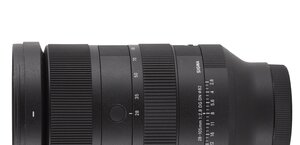Sigma 50 mm f/1.4 EX DG HSM
4. Image resolution

As can be seen from the graph above, the result of 28 lpmm, reached by Sigma, is undoubtedly the best among all. Should we be delighted with it? Perhaps not delighted, because the decency level is near 30 lpmm, but certainly Sigma deserves a few warm words for its performance. It is worth notice that the Canon EF 35 mm f/1.4L wide open had the result of 31.1 lpmm which proves that good results can be obtained even by f/1.4. We can’t forget, though, that the Canon in question is three times more expensive than the tested Sigma.
Please Support UsIf you enjoy our reviews and articles, and you want us to continue our work please, support our website by donating through PayPal. The funds are going to be used for paying our editorial team, renting servers, and equipping our testing studio; only that way we will be able to continue providing you interesting content for free. |
- - - - - - - - - - - - - - - - - - - - - - - - - - - - - - - - - - - - - - - - - - - - - - - -
On slight stopping down Sigma fares wonderfully. By f/2.8-5.6 aperture range we get MTF results on the level of 44 lpmm, so near the highest values possible to achieve on the Canon 20D. It’s clearly Sigma’s advantage over the Canon 1.4/50, which was able to reach just 40 lpmm. Nikkor, Pentax and Sony might compete with Sigma in record breaking by f/4.0 – 5.6 but by f/2.8 they are significantly worse.
As you can see in the picture presented above, the Sigma’s frame edge is a bit worse than the frame center but it’s more because of the record breaking results from the center than because the weakness of the edge performance. You should note the fact that from f/2.0 onwards we get useful pictures with the MTF values of 30 lpmm and more. Other lenses in this class could pass the 30 lpmm limit only by f/2.8 In this category Sigma seems to win again.
Towards the end, but not at the end, we present traditionally the excerpts of our test chart, based on JPEG files saved along with RAW files, which are used to generate the resolution graphs.

This time, we finish the chapter with an interesting comparison. In our editorial office we had, apart from the tested Sigma, also the Canon EF 50 mm f/1.4 UMS and the Zeiss Planar 50 mm f/1.4 T* on a Nikon mount for our disposition at the same time. The latter was, by using an adapter, put on a Canon 20 D, what allowed us to stage a direct duel of all the three instrument. It’s results are presented below.
| Frame center - f/1.4 | |||
|
|
|
|
|

|

|

|
|
| Frame center - f/2.8 | |||
|
|
|
|
|

|

|

|
|
Trying to interpret the excerpts posted here you can notice that the Zeiss fares the best, although its advantage over Sigma is minimal. Both instruments are significantly better than Canon.






